Project Network Diagram: What It Is and How to Make It
As overwhelming as starting a new project can be, a project network diagram should make organizing activities child’s play.
A project network diagram is a project management tool that helps you visualize your project’s workflow, giving you a graphical, sequential overview of all project activities.
Read on to learn which types of project network diagrams exist, why you should use them, and how to create an effective one yourself.

- A project network diagram is a graphical representation of project activities, their flow, and their interconnections.
- The 2 main types of project network diagrams are activity-on-arrow (AOA) and activity-on-node (AON) diagrams.
- The AON diagram is the standard nowadays and comprises a series of nodes, which represent activities, and arrows, which indicate the dependencies between those activities.
- To make an accurate project network diagram, it’s necessary to properly define the project activities and estimate their duration.
Table of Contents
What is a network diagram in project management?
A network diagram in project management is a visual tool that depicts the entire project workflow.
A project schedule is often shown in the form of a graph, such as a Gantt chart, a milestone chart, or a project schedule network diagram.
Typically, the network comprises a series of boxes (nodes) connected by arrows. These elements represent project activities and the interrelationships that govern the order in which they’ll be completed.
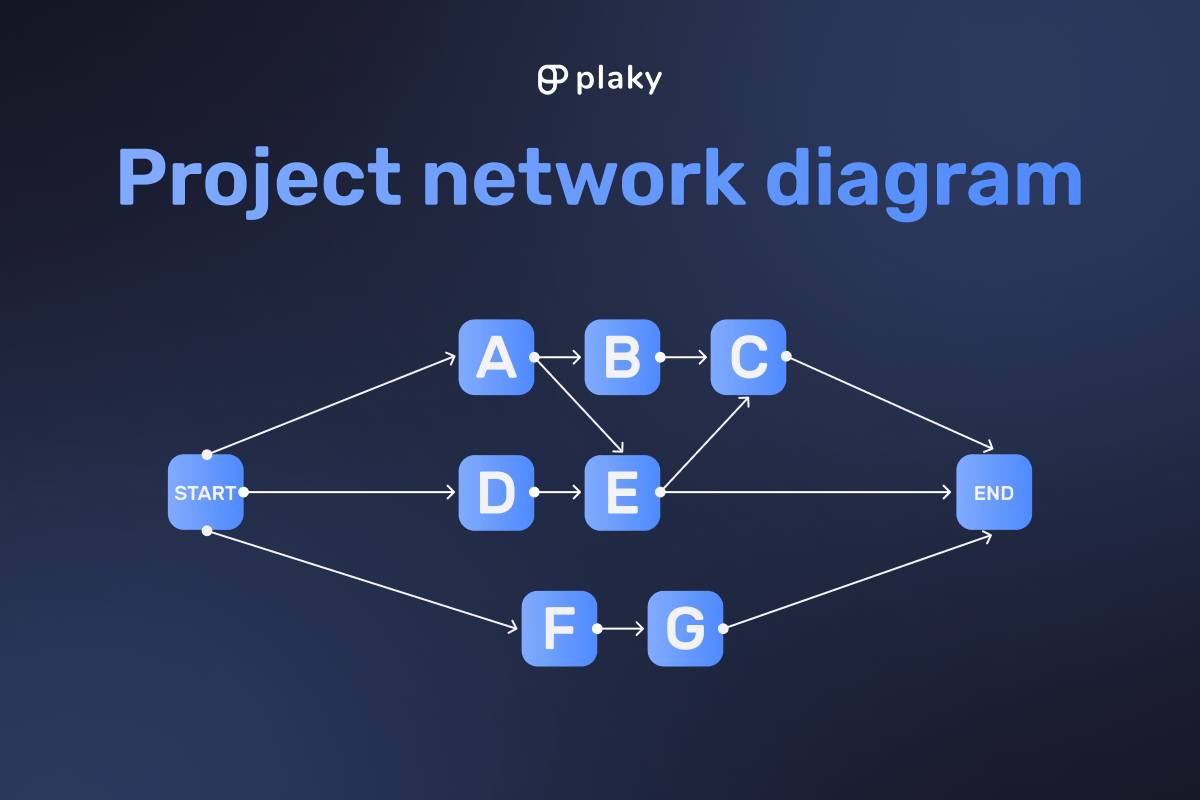
What is a project schedule network diagram in project management?
A project schedule network diagram is a graphical representation of project schedule activities and how they are interconnected.
Project activities are interrelated — they share logical relationships or dependencies that serve as the basis for their sequencing and scheduling.
A project network diagram addresses and depicts those elements, acting as a visual project roadmap that guides the project manager through the project’s life cycle.
Most often, the diagram is made in project management software, but it can also be done manually. Either way, it should show project work chronologically, so it is drawn from left to right.
💡 Plaky Pro Tip
Project network diagrams are made as part of activity sequencing, one of the processes of project time management. To learn more about project time management and its processes, check out the guide below:
Benefits of using a project network diagram
Some of the major benefits of using a project network diagram are that it:
- Defines and streamlines the project workflow, identifying all the activities that should be done and the sequence they should follow,
- Visually communicates key project data, such as critical activities and dependencies, helping the project manager better understand the project and pinpoint errors and potential bottlenecks,
- Helps both identify and resolve project issues,
- Enables easier project planning and simplifies scheduling,
- Allows for more methodical resource allocation,
- Improves the team’s understanding of the project scope and everything they must do to meet the project goals,
- Boosts the project team’s efficiency, productivity, and performance, and
- Enhances the team’s project buy-in, giving them a deeper insight into their responsibilities and level of contribution.
Additional benefits highlighted by experts
When asked about the benefits of project network diagrams, Jan Schiller, Partner and Chief Project Officer at Berkshire Consulting LLC, highlighted conflict and issue identification:

“Any scheduling conflicts or issues are identified proactively when there is adequate project runway to address and resolve those issues to ensure a predictable schedule.”
She also reflected on the use of visual aids to support better communication and manage project stakeholder expectations:

“Because visual representations of project information are easier to understand than a view of all of the source data, project communications, and project expectation management become easier.”
💡 Plaky Pro Tip
What role does communication play in project management and how can you improve it to support your project’s success? Read all about it and get useful tips in the guide below:
Drawbacks of using a project network diagram
The main drawbacks of using a project network diagram are that it:
- Requires a lot of time, effort, and attention to detail to produce, which also makes it costly,
- Can be too complex to understand if the scope is too large,
- Depends on accurate data to fulfill its purpose, and
- Isn’t immune to human error or misinterpretation.
What is the difference between a WBS and a project network diagram?
The main difference between a work breakdown structure (WBS) and a project network diagram is that a WBS doesn’t list project tasks chronologically.
A WBS is a hierarchical breakdown of the project that shows 100% of the project work divided into manageable components.
In contrast, a project network diagram has a sequential structure and shows project activities in the order they should be completed.
These 2 project management tools also differ in form. While a WBS often takes the form of a tree diagram, a project network diagram flows from left to right.
Besides that, a WBS usually has work packages as its terminal elements — the lowest components that cannot be further broken down.
Each work package acts as a mini project and comprises all the activities that must be performed to achieve the desired outcome. These are the activities you can use to sequence a project network diagram.
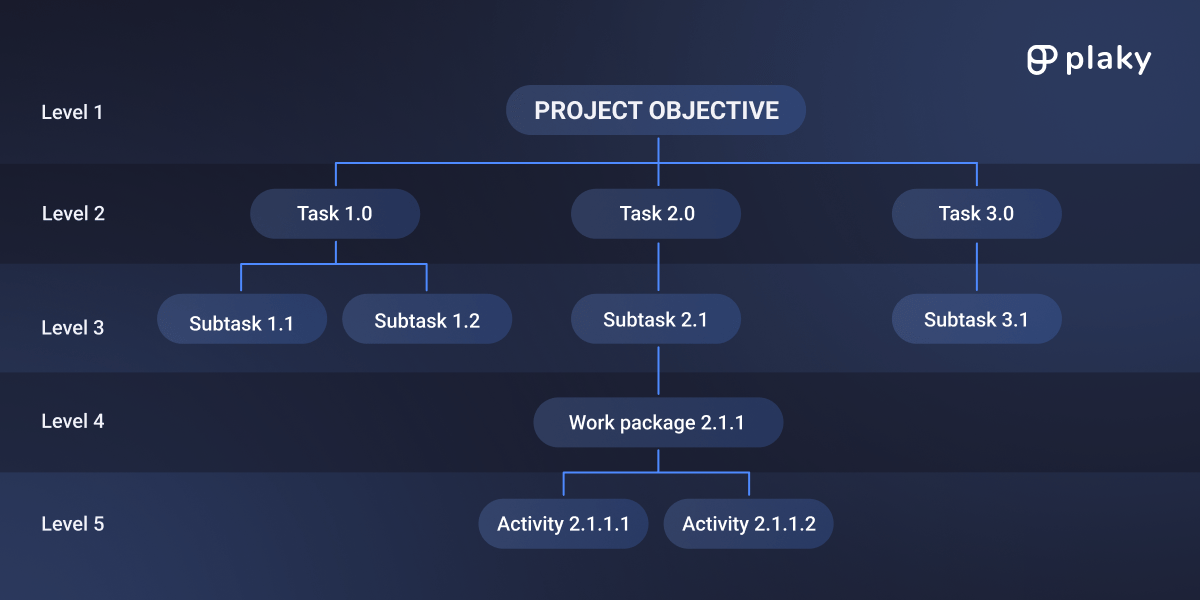
Types of project network diagrams
There are 2 main types of project network diagrams:
- Activity-on-arrow diagram (arrow diagramming method), and
- Activity-on-node diagram (precedence diagramming method).
Both types are arrow diagrams, as they include arrows as key elements.
The main difference between these 2 diagrams is how they represent project milestones, activities, and their interconnections.
Let’s go through both in more detail.
Type #1: Activity-on-arrow diagram (AOA)
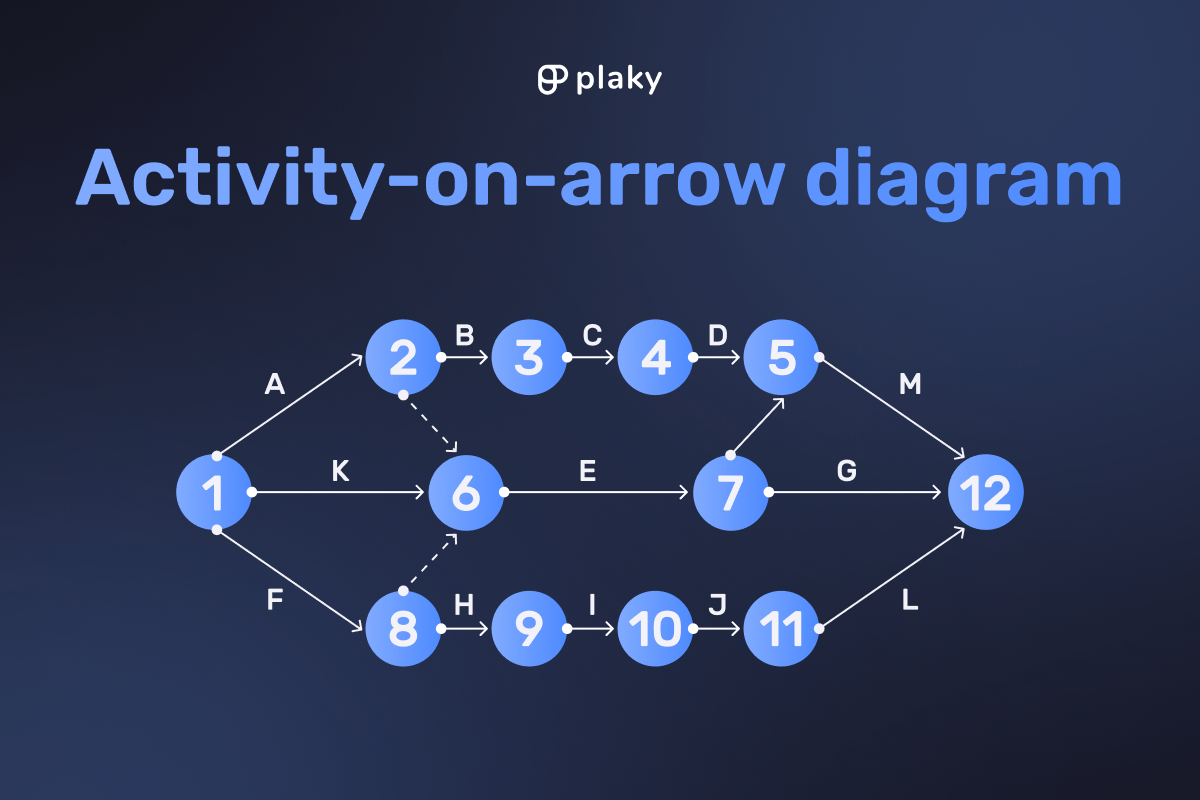
An activity-on-arrow diagram or the arrow diagramming method (ADM) uses arrows to represent the project activities and nodes to depict major milestones or events.
Traditionally, the nodes are drawn as circles. The first circle represents the start event and is also called the i-node. The other circle represents the finish event and is also called the j-node.
Between these nodes is the arrow, whose tail represents the start, while its head marks the end of an activity.
The arrow itself shows the logical relationship between the activities, and the length of the arrow indicates an activity’s duration.
The AOA diagram only shows 1 type of activity relationship — finish-to-start (FS). Due to this, it might be necessary to include dummy activities as well — broken arrows that signify indirect relationships between tasks.
These dummy activities don’t take part in the sequence and have no duration. Instead, they indicate benchmarks that should be honored before moving on to a certain activity.
A great example of the use of the arrow diagramming method is PERT (Program Evaluation and Review Technique), a type of network diagram developed by the US Navy to coordinate defense projects.
However, the AOA diagram now has limited use in project management since PMs tend to rely on computers for project scheduling.
Type #2: Activity-on-node diagram (AON)
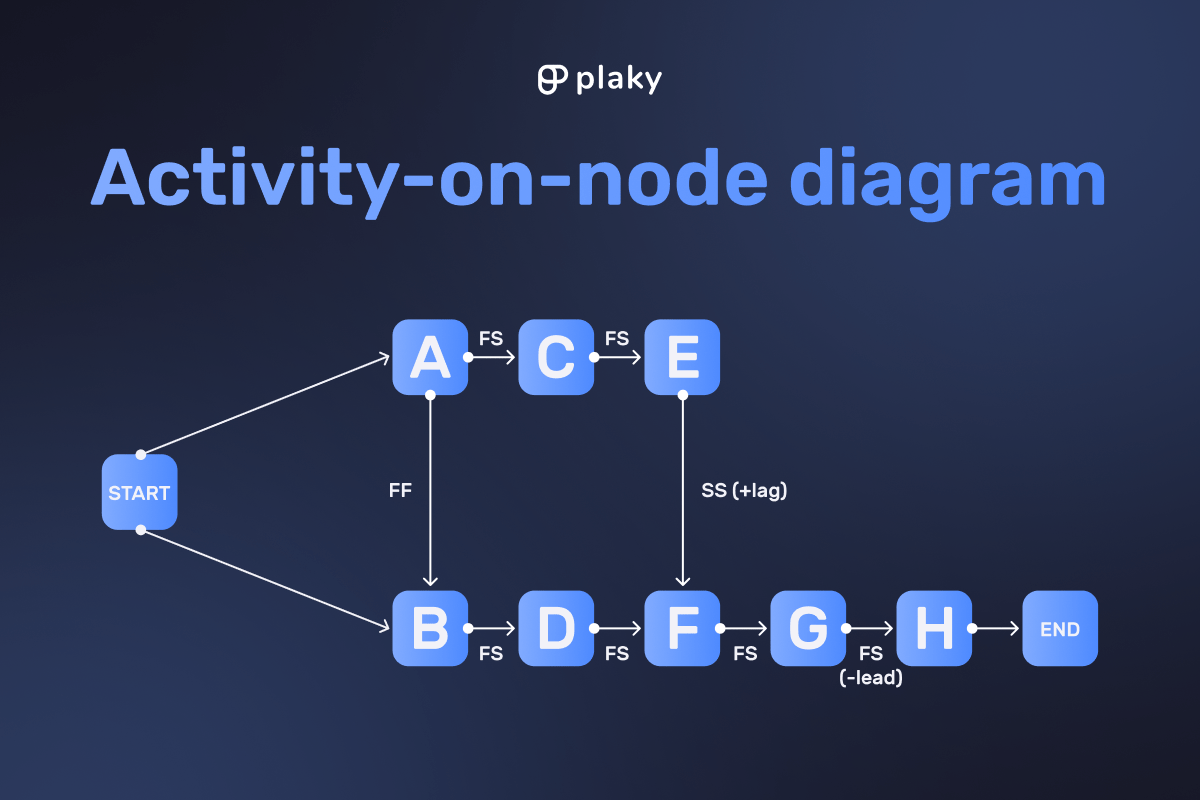
An activity-on-node diagram or the precedence diagramming method (PDM) uses nodes to represent project activities and arrows to reflect the dependencies between tasks.
The activity nodes are shown as boxes and linked with arrows. The arrows indicate the 4 types of task dependencies:
- Finish-to-start (FS) — the successor activity cannot begin until the predecessor activity has been completed,
- Finish-to-finish (FF) — the successor activity cannot be finished until the predecessor activity has been completed,
- Start-to-start (SS) — the successor activity cannot begin until the predecessor activity has started,
- Start-to-finish (SF) — the successor activity cannot be finished until the predecessor activity has started.
Start-to-finish is the rarest, while finish-to-start is the most common type of relationship between predecessor and successor activities.
The AON diagram can also capture lead and lag times.
Lead time refers to the amount of time a successor activity can be advanced. For instance, if Activity A lasts 5 days, and Activity B has a lead time of 1 day, Activity B can start 1 day before Activity A is completed.
In short, lead time is the overlap between 2 activities and is associated with the finish-to-start dependency.
On the other hand, lag time refers to the amount of time a successor activity can be delayed. For example, if Activity C lasts 6 days, and Activity D has a lag time of 2 days, Activity D can start only 2 days after Activity C is completed.
In other words, lag time is the delay between 2 activities and can be applied to tasks regardless of the dependency.
In an AON diagram, the lead and lag times can be marked on the arrows, denoted with – and + symbols.
How to create a network diagram for project management
You can create a project network diagram in 5 steps:
- Identify and define all project activities,
- Estimate the duration of all activities,
- Sequence the activities,
- Draw the project network diagram, and
- Review and continuously update the diagram with current data.
Let’s go through each step in more detail.
Step #1: Identify and define project activities
The first step is to properly define project activities since they are the main components of your network diagram.
As an example, let’s say that our project objective is to open a beauty salon.
We can rely on our work breakdown structure for this step, which can be shown in project management software like Plaky:
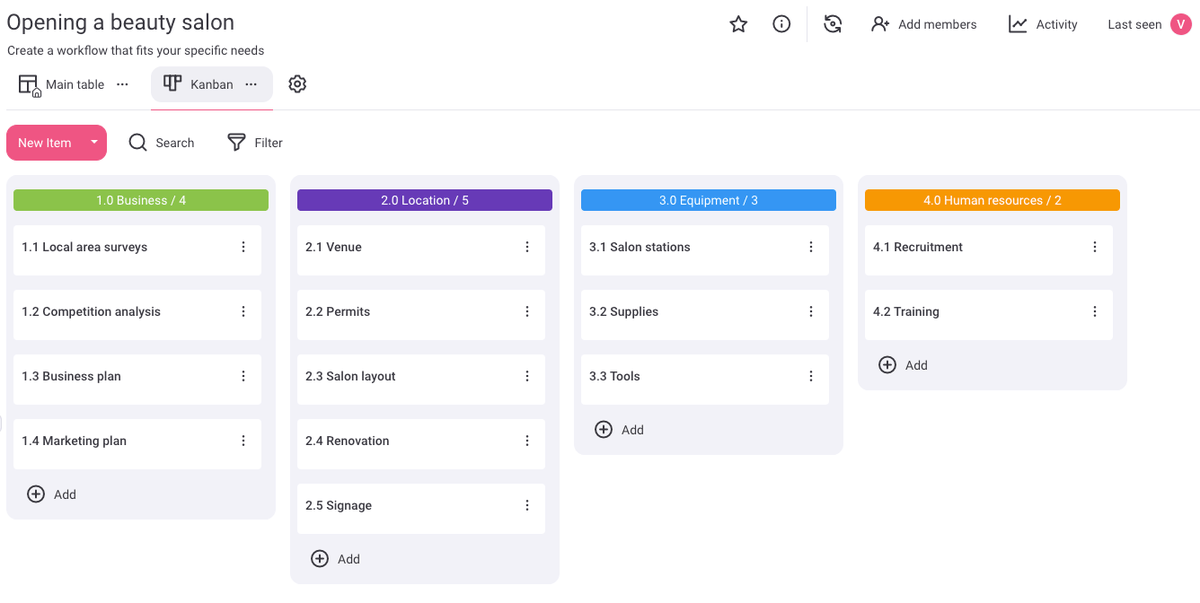
This is an example of a simple 3-tier WBS that lists the project objective, tasks, and subtasks.
To keep it all neatly organized, we will create a separate board for work packages and activities.
For our project network diagram example, let’s focus on task 4.0 — Human resources.
When broken down, this task comprises the following 2 subtasks:
- 4.1 — Recruitment, and
- 4.2 — Training.
We’ll focus on the recruitment subtask, which consists of 4 work packages:
- 4.1.1 — Hire a receptionist,
- 4.1.2 — Hire a hairdresser,
- 4.1.3 — Hire a stylist,
- 4.1.4 — Hire a makeup artist.
Since we didn’t define the project activities in our WBS, we can now create an activity list for each work package. Let’s focus on WP 4.1.1.
The activity list should contain activity attributes — descriptive components that further define each activity in your project.
These attributes provide key information about the activities, such as:
- Who’s responsible for them,
- What kinds of project resources they require,
- Each activity’s level of effort,
- Predecessor and successor activities, etc.
Since this list defines the activity relationships (dependencies) we previously talked about, it’ll help us make an accurate diagram.
Here’s our activity list for WP 4.1.1, as shown in Plaky:
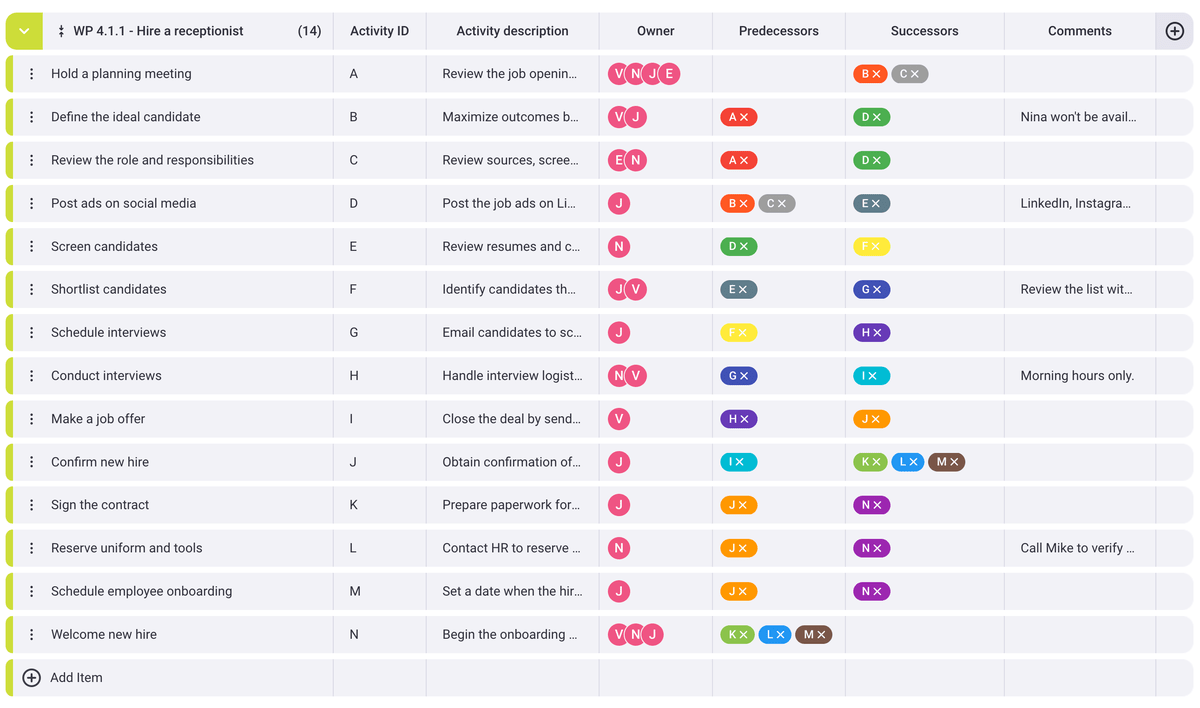
To show you how to draw both the AOA and AON diagrams, we’ll use only the finish-to-start dependency in this example.
💡 Plaky Pro Tip
If you want to learn more about the recruitment process in HR and how to maximize its potential, check out the guide below:
Step #2: Make duration estimates
Once you have your activity list, it’s time to estimate how long each activity will take.
The question is — how do you make good estimates?
Well, according to Jan Schiller, making accurate estimates requires a bit more than just figuring out the length of each activity:

“The best estimates take both effort and duration into consideration and reflect the allocations of resource(s) performing the tasks. Create the estimate yourself if the resource(s) performing the task are not yet available. Validate your estimate with those resources when they become available.”
Generally speaking, you should be able to back up your estimates with knowledge or experience. However, estimates can also be based on the conclusions you derive from project assumptions.
Some of the most commonly used estimation techniques to rely on for this step include:
- Analogous estimating (apportionment method),
- Parametric estimating,
- Expert judgment,
- Group decision making,
- Heuristic estimating (rule of thumb),
- Reserve analysis,
- Three-point estimation, and
- Bottom-up estimating.
For our example, we’ll use the following duration estimates:
- 1 day — activities A, B, C, D, G, I, J, K, L, M, and N
- 2 days — activity F,
- 3 days — activity E, and
- 4 days — activity H.
💡 Plaky Pro Tip
Some of the estimation methods used to determine the duration of project activities are also used for project management budgeting. Learn more about them here:
Step #3: Map out the activity sequence
Now that we have an activity list and know each activity’s duration, we can focus on activity sequencing.
To make mapping the diagram easier, we can refer to a predecessor table. This table should contain information about the activities, their duration, and their predecessors.
| ACTIVITY | DURATION (days) | PREDECESSOR |
|---|---|---|
| A | 1 | — |
| B | 1 | A |
| C | 1 | A |
| D | 1 | B, C |
| E | 3 | D |
| F | 2 | E |
| G | 1 | F |
| H | 4 | G |
| I | 1 | H |
| J | 1 | I |
| K | 1 | J |
| L | 1 | J |
| M | 1 | J |
| N | 1 | K, L, M |
Based on this, we can make a rough map of the activity sequence. Here’s how that might look:
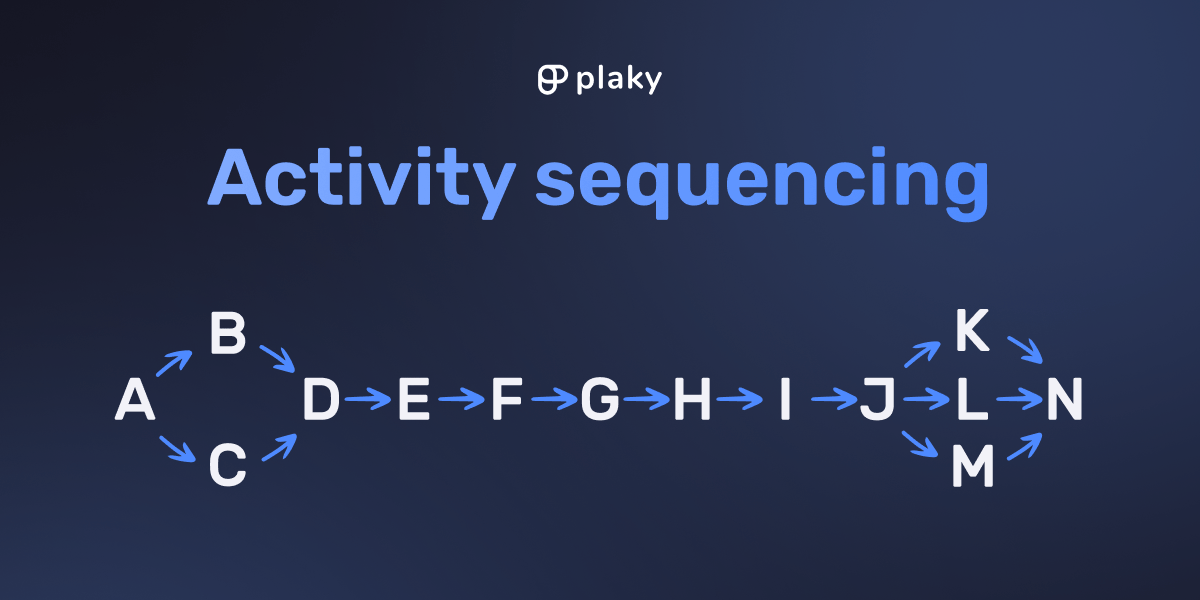
According to Jan Schiller, the project’s activity sequence should be well thought out:

“Sequence the tasks to logically reflect reality. What tasks must be completed before others can begin? What tasks must wait for another task to complete? What tasks must start at the same time, or finish at the same time? When a resource is fully allocated to the tasks, reflect the fact that a resource can only work on one thing at a time by sequencing accordingly.”
Step #4: Draw the network diagram
Now, just use this information to make your diagram of choice.
Whether you use a tool or draw it by hand, remember the following:
- Your diagram should have only 1 start and end point.
- The diagramming symbols you use should be universally comprehensible and consistent.
- In case you use some other symbols, make sure to define them properly in a diagram legend.
- Use straight arrows and try not to overlap them.
- Don’t overpopulate your AOA diagrams with dummy activities.
- Keep it simple — the diagram should be easy to understand at a glance.
Based on the example above, here’s what the AOA diagram looks like:
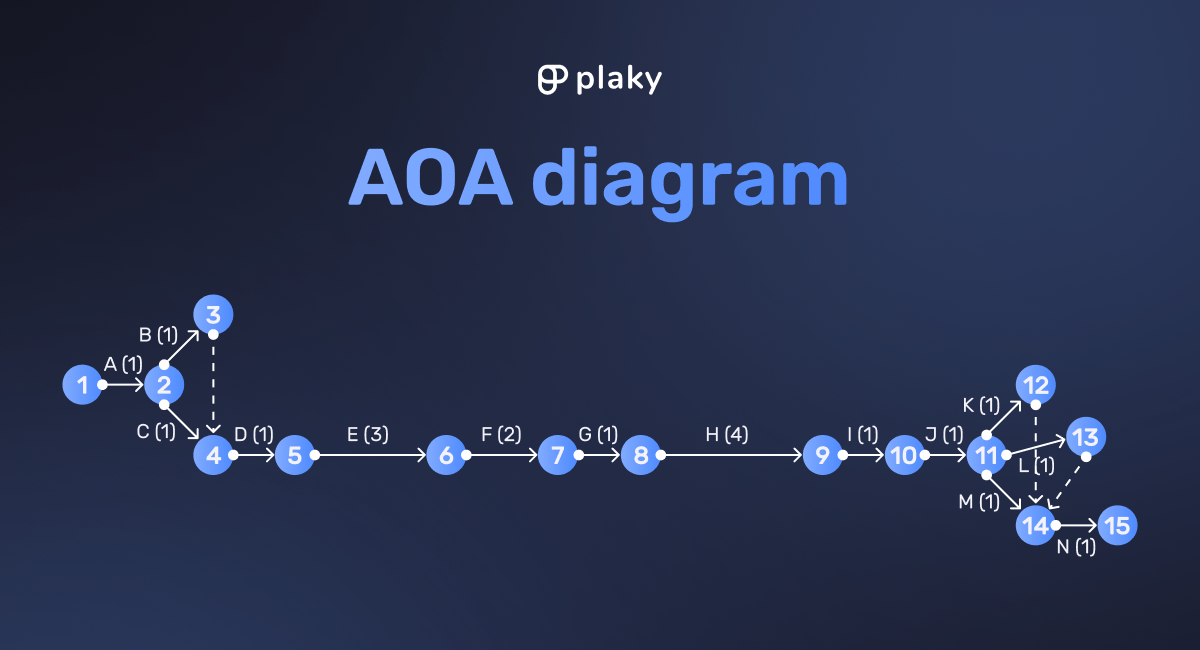
Since this type of diagram is not used so much these days, you’re more likely to make an AON diagram for your projects, especially if you want to find the project’s critical path.
Here’s what the AON diagram for this example looks like:
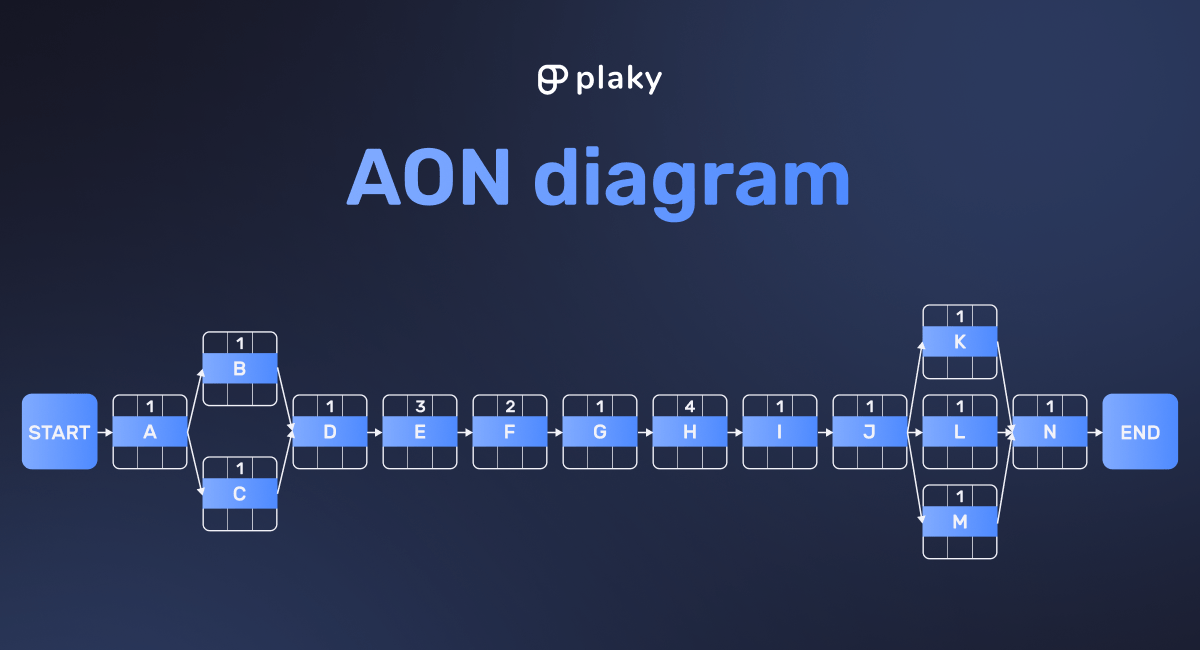
Notice the nodes in this diagram and how they’re split into 7 panels. Since AON diagrams are used in the critical path method, you can fill in the blanks with other activity values, such as:
- Early start and finish times,
- Late start and finish times, and
- Total float.
Since some activities have multiple predecessors or successors, the diagram must illustrate that via path divergence or path convergence.
Take note of the arrows in this diagram as well.
According to PMI’s PMBOK® Guide – Sixth Edition, a path divergence occurs when an activity has more than 1 successor. For example, that’s activity A, which is succeeded by activities B and C.
In contrast, a path convergence occurs when an activity has more than 1 predecessor. In the above diagram, that’s the easiest to notice if you look at activity N, which has 3 predecessors — activities K, L, and M.
💡 Plaky Pro Tip
Finding the critical path is the first step in managing your projects using critical chain project management. Learn about the origin of this methodology, its pros and cons, and how it differs from CPM in the guide below:
Step 5: Review and update the diagram with current data
Once you have your diagram, all that’s left is to review how easy it is to understand and keep updating the data.
Apart from using a project management tool to create the diagram, Jan Schiller recommends adding a summary view as well:

“Support project communication with a summary view of the project network diagram. This will help project teams and executives alike to understand the way the work must flow to achieve the project’s result.”
However, if the diagram is already too big and seems disorganized, she believes it might be a good idea to switch tools:

“Switch to a Gantt chart visual when the project network diagram becomes too large and unwieldy. A project network diagram does not replace the need for a Gantt chart (which visually places the tasks in the context of a timeline).”
Jan also emphasizes the importance of relying on accurate planning data when making the diagram:

“The project network diagram is a critical prerequisite to determining a project’s schedule (and therefore, project costs). [But] the project network diagram is only as good as the planning data the diagram is visually representing: a complete list of tasks that are accurately estimated and sequenced properly.”
To ensure the diagram’s accuracy and general usefulness, Jan’s advice is simple but exact:

“Develop the initial project network diagram thoughtfully. Keep this data current throughout the life of your project.”
How to organize project activities with Plaky
Keeping up with project activities can be a challenge, especially if you primarily handle complex endeavors.
But as they are the main input for making effective project network diagrams, you must define and organize them properly.
Plaky is your one-stop-shop for organizing projects of any size — from start to finish — that keeps all project information centralized for easy access.
As a versatile project management tool, Plaky lets you create work breakdown structures and activity lists to use for your network diagrams, opening your projects up to all the benefits listed in this guide.
Plaky can also be used as collaborative task management software that ensures team operations run smoothly. As it aims to bring order to disorder, Plaky makes it effortless to:
- Prioritize tasks,
- Track task progress and status, and
- Assign responsibilities and task ownership.
Ultimately, Plaky also makes managing and executing projects practically effortless, allowing you to:
- Create project boards from scratch or use project management templates for new projects,
- Use fields to capture all pertinent information about activities and tasks,
- Communicate in task cards via comments and share task-related files, and
- Get project activity updates in real time and keep the team in the loop with the activity log.
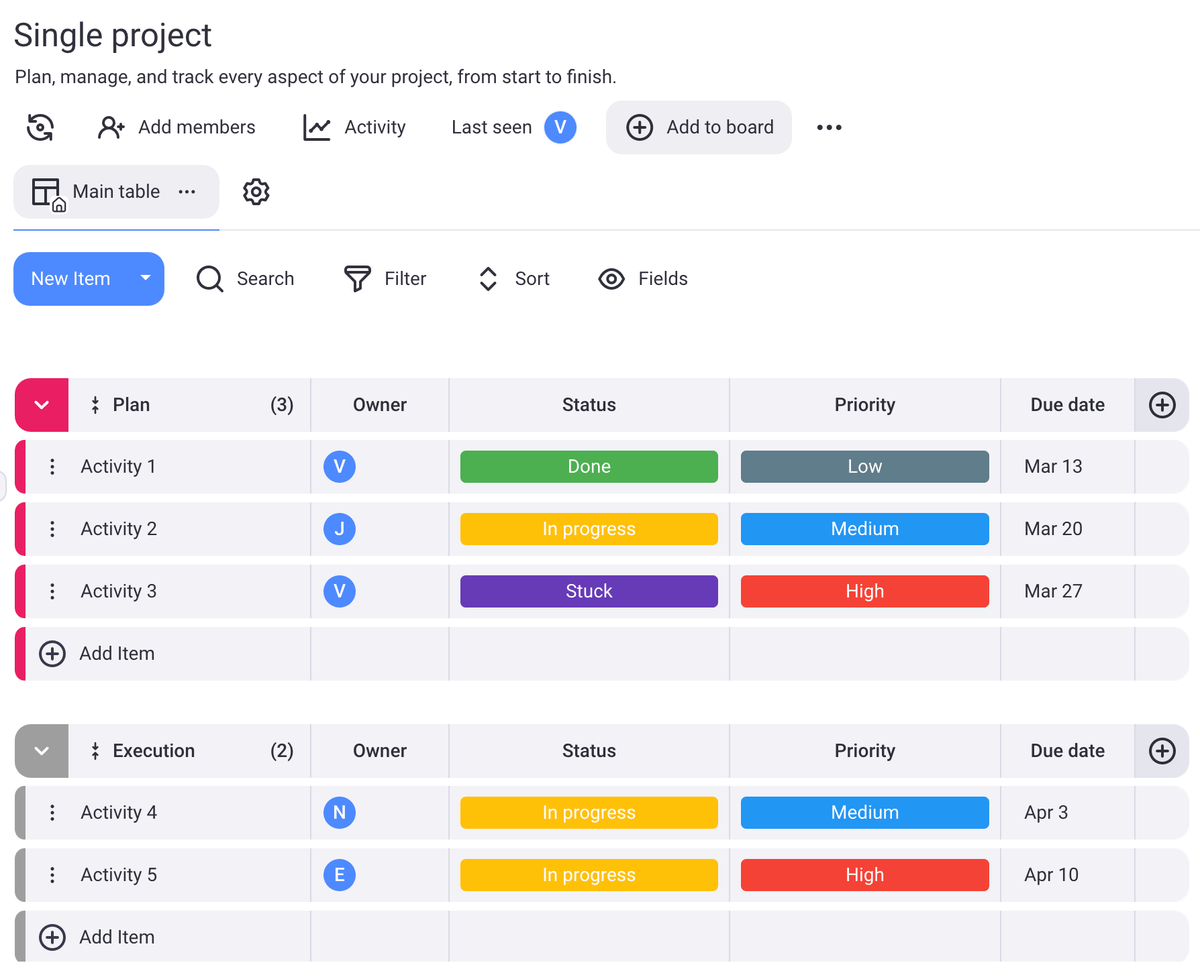
Preparation is key when tackling project network diagrams, and there’s no better way to ensure your project activities are properly organized than by using project management software. Whether used to break down a project into tiny, more manageable pieces or create detailed activity lists, Plaky’s got you covered. Sign up for a free Plaky account today.
References:
- Danao, M. (2023, October 5). What is PERT in project management?. Forbes. Retrieved December 19, 2023 from https://www.forbes.com/advisor/business/software/pert-project-management/
- Project Management Institute. (2017). A Guide to the Project Management Body of Knowledge (6th ed.). Project Management Institute. https://www.goodreads.com/en/book/show/35477553
 Project Management Hub
Project Management Hub 











